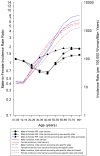Sex disparities in cancer incidence by period and age
- PMID: 19293308
- PMCID: PMC2793271
- DOI: 10.1158/1055-9965.EPI-08-1118
Sex disparities in cancer incidence by period and age
Abstract
Background: Cancer epidemiology articles often point out that cancer rates tend to be higher among males than females yet rarely is this theme the subject of investigation.
Methods: We used the Surveillance, Epidemiology and End Results program data to compute age-adjusted (2000 U.S. standard population) sex-specific incidence rates and male-to-female incidence rate ratios (IRR) for specific cancer sites and histologies for the period 1975 to 2004.
Results: The 10 cancers with the largest male-to-female IRR were Kaposi sarcoma (28.73), lip (7.16), larynx (5.17), mesothelioma (4.88), hypopharynx (4.13), urinary bladder (3.92), esophagus (3.49), tonsil (3.07), oropharynx (3.06), and other urinary organs (2.92). Only 5 cancers had a higher incidence in females compared with males: breast (0.01), peritoneum, omentum, and mesentery (0.18), thyroid (0.39), gallbladder (0.57), and anus, anal canal, and anorectum (0.81). Between 1975 and 2004, the largest consistent increases in male-to-female IRR were for cancers of the tonsil, oropharynx, skin excluding basal and squamous, and esophagus, whereas the largest consistent decreases in IRR were for cancers of the lip and lung and bronchus. Male-to-female IRRs varied considerably by age, the largest increases of which were for ages 40 to 59 years for tonsil cancer and hepatocellular carcinoma. The largest decreases in male-to-female IRR by age, meanwhile, were for ages 30 to 49 years for thyroid cancer, ages >70 years for esophageal squamous cell carcinoma, and ages >30 years for lung and bronchus cancer.
Conclusion: These observations emphasize the importance of sex in cancer etiopathogenesis and may suggest novel avenues of investigation.
Conflict of interest statement
There are no financial disclosures from any of the authors.
Figures

tonsil cancer
skin excluding basal and squamous
esophageal squamous cell carcinoma
esophageal adenocarcinoma
anus, anal canal and anorectum
hepatocellular carcinoma
kidney and renal pelvis
thyroid
lung and bronchus

References
-
- US Institute of Medicine. Exploring the biological contributions to human health: does sex matter? J Womens Health Gend Based Med. 2001;10:433–9. - PubMed
-
- Zhang XH, Sasaki S, Kesteloot H. The sex ratio of mortality and its secular trends. Int J Epidemiol. 1995;24:720–9. - PubMed
-
- Kesteloot H. On the sex ratio of all-cause and disease-specific mortality rates worldwide. Verh K Acad Geneeskd Belg. 2007;69:105–30. - PubMed
-
- Foster F. Sex differentials in cancer mortality and morbidity. World Health Stat Q. 1978;31:360–83. - PubMed
-
- Levi F, La Vecchia C, Lucchini F, Negri E. Trends in cancer mortality sex ratios in Europe, 1950-1989. World Health Stat Q. 1992;45:117–64. - PubMed
Publication types
MeSH terms
Grants and funding
LinkOut - more resources
Full Text Sources

